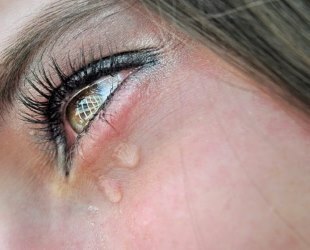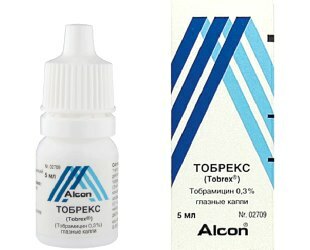
Tears physiologically wash the eyeball, supporting the conjunctiva in the wet state and removing the mote and foreign bodies.
Intensified lacrimation( epiphora) is an unusually abundant fluid secretion by the lacrimal glands.
This is a situation in which the equilibrium between the secretion of a secret and its withdrawal through physiological channels is disturbed.
Therefore, tears flow over the face, creating the impression that a person cries all the time.
This pathology can occur for various reasons: conjunctivitis, draft or a serious inflammatory process of the lacrimal glands.
Only the ophthalmologist can remedy this problem with the help of complex treatment. To sound an alarm is necessary, when tearfulness disturbs already during several days.
- 1. What is the pathology?
- 2. Causes of the appearance of
- 3. Treatment of
- 4. Preventive measures of
- 5. Increased tearing in a child
- 6. To those who wear lenses
- 7. Result of
What is the pathology?
Excess tearing can be divided into:
- mental;
- is neurogenic.
Mental tearing is considered a normal reaction to emotional or physical stress, for example, pain, which is the most common cause of tearing. Crying also applies to this type of tear formation.
The neurogenic nature of the phenomenon causes stimulation of reflexes associated with corneal trauma or inflammation. The conjunctiva is extremely sensitive to changes in the external environment and external irritations, such as, for example, bright light, dry or hot wind, allergens.
In this regard, a protective reaction - lacrimation - is activated. But with some diseases this phenomenon starts to cause discomfort, in addition it leads to even more severe irritation of the mucous membrane. Neurogenic type of lacrimation can accompany laughter, yawning, vomiting, coughing and tense visual work.
What can I do to relieve my condition if my eyes are constantly watering? To answer this question you need to understand where the endless stream of tears comes from.
The mechanism of the appearance of excessive tearing
The formation of this phenomenon can be both a violation of the excretion of tears outward, and their increased secretion. Therefore, two types of enhanced lacrimation can be distinguished: retention and hypersecretory. Let us analyze them further.
Retention - due to complete or partial obstruction of tear ducts. In this situation, tears produced in normal volume remain in the eye, not being able to go through tear-dropping pathways to where they should fall under normal conditions - into the nasal cavity.
In the retention type of pathology, increased tear is the main and often the only complaint of the patient. For some professions( for example, a driver), it even deprives him of his ability to work. Tears can flow from one eye or both.
Hyper-secretory - lacrimal glands produce excess fluid volume compared to the norm. Along with other symptoms, it is observed in inflammatory diseases and eye injuries.
Reasons for the appearance of
Causes of retention of tearing
The causes of excessive discharge of tear fluid in the retention type of pathology are diverse. This problem can be caused by:
- muscle weakness of the eyelids;
- by constriction or blockage of lacrimal canals;
- overlapping holes for the exit of tears with cicatricial changes;
- by a tumor or inflammation of the lacrimal sac( dacryocystitis, usually one-sided);
- by turning or skewing the edge of the eyelid, as a result of the displacement of the lacrimal gland;
- abnormal position or occlusion of lacrimal points, usually lower;
- stricture( constriction) or complete obstruction of the lacrimal nasal canal.
The last two reasons are the main ones in the occurrence of retention enhanced release of tear fluid.
Causes of hypersecretion of tears
A hypersecretory type of phenomenon is always associated with inflammatory diseases or trauma to the organ of vision. Approximate list of factors causing abundant separation of the secretion of the lacrimal glands:
- blepharophimosis - increased tear and inflammation of the cornea( keratitis with incomplete closure of the eyelid);
- conjunctivitis - lacrimation, sensation of sand, itching and redness of the conjunctiva;
- corneal injury or burn - trauma causes painful blinking;
- intense exposure to sunlight or bright light;
- allergy;
- foreign body of the cornea - a person with a stream of tears flowing, he is experiencing severe pain, blurred vision, cornea blushes;
- episcleritis and scleritis - the disease is usually one-sided, causes increased tearing, photophobia( photophobia), tenderness in palpation of the eyeball;
- corneal ulceration - with this dangerous disease( fortunately, extremely rare), increased production of tears is accompanied by severe eye pain and photophobia;
- trachoma - increased tearing appears at the very beginning of the disease, then bubbles appear on the conjunctiva, reddening and edema of the eyelids, pain, photophobia and exudate formation.
Treatment
Therapeutic measures aimed at eliminating eye lacrimation should have a comprehensive approach. For these purposes, doctors appoint their patients to use special drugs in combination with folk recipes.
Medications

There are several classifications of medications that are actively used in ophthalmology.
The following main groups of medicines stand out:
- antimicrobial;
- is an anti-inflammatory;
- antiallergic.
The group of antimicrobials includes antibacterial, antifungal and antiviral agents.
Antibacterial medicines find their application for the prevention and treatment of diseases of the eyeball and its appendages of a chronic nature.
The most commonly used drugs:
- tetarcicline and chloramphenicol - Tetracycline ophthalmic ointment 1%;
- gentamicin - Gentamycin sulfate solution, 0.3%;
- Tobramycin - Tobrex;
- fusidic acid - Fucitalmic;
- erythromycin - ointment erythromycin 10 000 U / g.
Combined medicines are being actively used to treat increased lacrimation. A vivid example of such a drug is Colbiocin.
Its composition presupposes the presence of chloramphenicol, tetracycline and colistin. Colbiocin has a bactericidal effect on many gram-negative bacteria and is active against fungi.
Folk remedies

Traditional therapeutic measures are aimed at eliminating the inflammatory process, which contributed to the formation of pathology.
Folk medicine is simply overcrowded with such recipes.
Very useful are such herbs as aloe, chamomile, calendula, plantain.
Remove the spoon from any of the above medicinal herbs and pour a glass of boiling water. Wait an hour until the broth is infused, filtered and applied to compresses. Prophylaxis of the presented pathology is an important point, because it is better to prevent the onset of the disease in advance, than later suffer in search of effective therapy. Preventive measures include the following: When none of the above methods yielded the desired result, and you grabbed an infection, you should immediately register for an appointment with a specialist. He will prescribe the necessary medications and indicate in what dosage it is necessary to administer them. With properly left therapy, all symptoms of lacrimation should go away after a few days. In small patients, problems with outflow of tears are caused by a violation of outflow of fluid from the lacrimal canals. Parents should understand that lacrimation itself is a very dangerous process. If it is accompanied by the release of pus, has a long-lasting nature and causes significant inconvenience to the child, then without consulting a specialist here is indispensable. When the disease progresses in severe form, cleaning of the lacrimal ducts will be required. The causes of of a similar pathology can be as follows: lenses Increased allocation of tears is a common problem for people who use contact vision correction. The reasons here can be: For those who prefer lens points, you need to develop some habits that minimize discomfort and lacrimation when using them: If, despite all the measures taken, the lenses still cause severe discomfort and the eyes continue to water-it is better to refuse contact correction and use glasses. Or wear the lens as little as possible. Some people, because of the increased sensitivity of the cornea, wear contact lenses in general is contraindicated. Let's sum up a little. If a person's eyes start to water, the first thing to do is to find out the cause of this phenomenon. When the provoking factor has been determined, it is possible to begin treatment and to stop the symptoms. Doctors forbid self-medication, as such activities can lead to serious complications. Preventive measures

Increased lachrymation in the child
Those who wear
The result of
